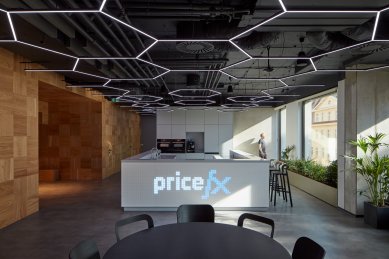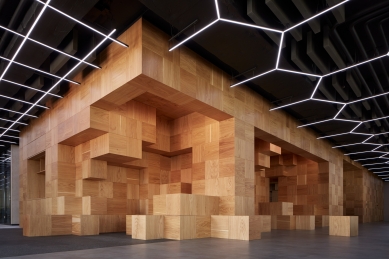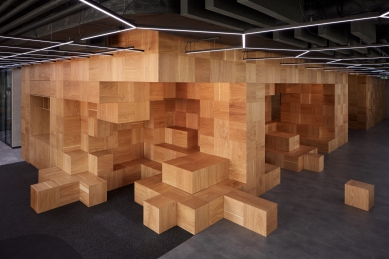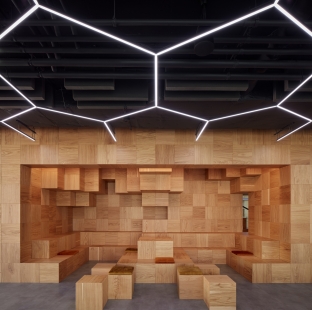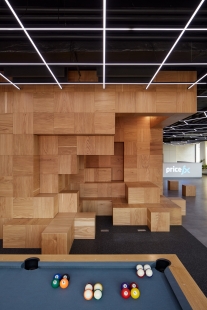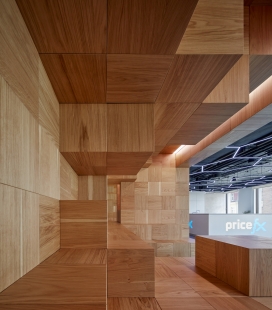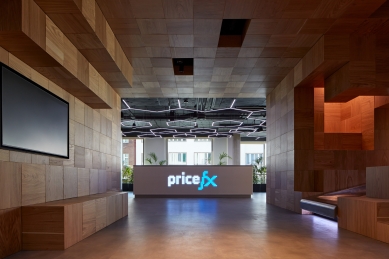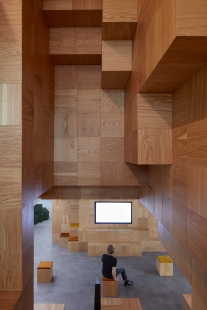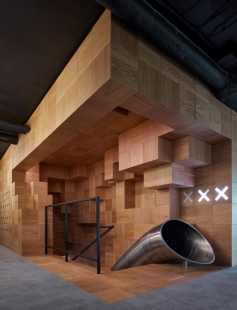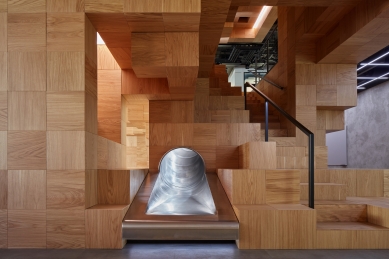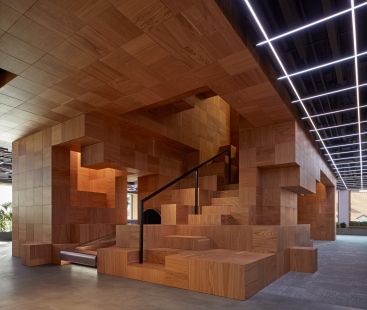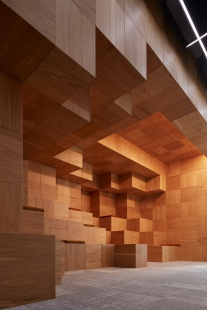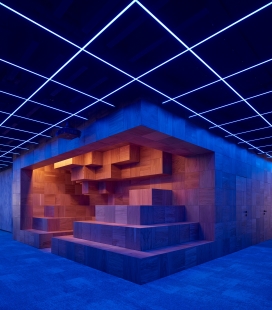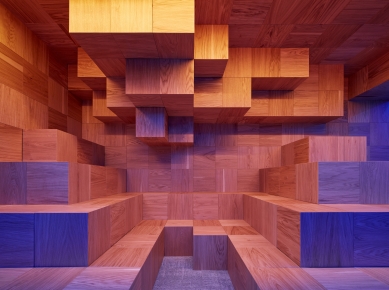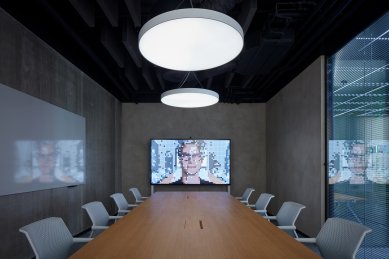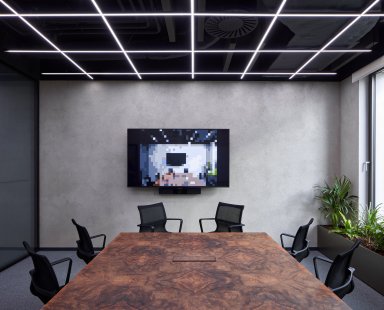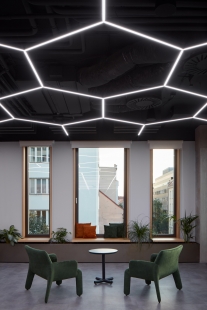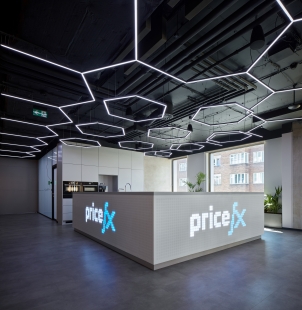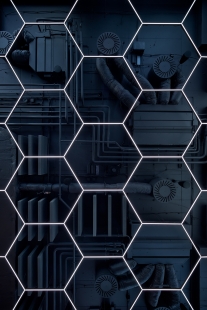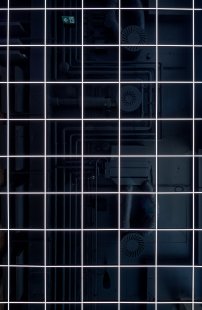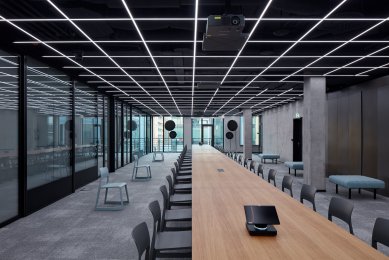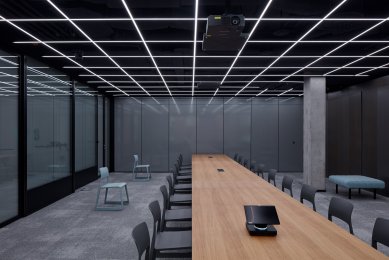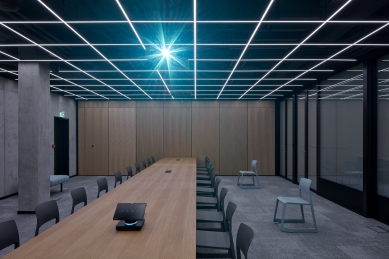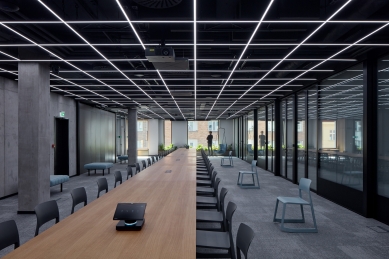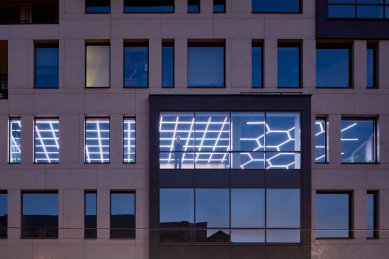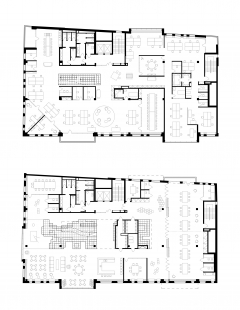
Price f(x) extension

Changes in work habits brought about by digitalization, which the pandemic only accelerated, are in the blood of Price f(x). Both the management and employees of Price f(x) use their offices primarily for meetings that stimulate creative dialogue. By nature, they are an open space for variable use that does not conform to the stereotypes of work cubicles or traditional open-plan spaces. In 2015, we responded to these visionary ideas with our design for the first floor of the offices. We expanded it with an additional floor in 2020 during the pandemic, which intensified some aspects of shared office usage.
The main task was to expand the basic offices with another floor for maximum flexibility. Vertical connection between two floors can be problematic if the natural flow of the space is to be preserved. We tectonically connect the two floors with a structure made of thousands of wooden pixels, which modulates the space around it and becomes its internal dominant feature. At the core of the structure is a new interior staircase and, for the brave, a slide. Inside the wooden cells, personal lockers, changing rooms, and functional rooms are hidden; individual fragments also organically create nooks intended for informal seating and public presentations.
The regular structure is also reflected in the universal light grid above the entire space, which acts as a screen cut down to individual pixels (LEDs). It is also projected onto the bar counter/display, which functions as a reception desk. The light interface is a dominant feature not only in the internal spaces. The glowing ceiling extends into the area of Karlín, making it impossible to overlook in the nighttime landscape.
The spaces function differently from the perspective of an employee and a visitor and differ from the very first experience upon entry. One can start the day with breakfast in the shared professional kitchen, which serves as a bar for employees and visitors alike. The lower floor serves as a meeting place, relaxation zone, and conference hall. It is multifunctional, serving as a meeting room with a table for 50 people, and can also be flexibly divided into units, whether for hot desk spaces or smaller meeting rooms. Thanks to a mobile acoustic partition, it can be utilized as a recording studio.
Furthermore, presentation rooms are scattered across the floor with a range of uses from video conferencing rooms to informal open-tiered amphitheaters equipped with retractable screens. Finding a space suitable for the format of a meeting is never a problem.
Regulation System
The capacity limit for meetings are the inputs and outputs of the media (ventilation, air conditioning and heating performance, hygiene facilities capacity, etc.) of individual spaces. However, at one moment, the entire company can gather in the café or in a hundred-seat conference hall to plan visions for the future - or disperse and tackle daily work matters in small teams. Therefore, we do not distract employees in the space (classic open space with square meters per person). We distribute the room capacities over time by regulating the environment.
The comprehensive regulation system measures and evaluates environmental data in real time. Thanks to this, it knows how many people are present in which room, what the air temperature is, and the intensity of ventilation, and can dynamically adjust the color of the lighting. The system can control each chip, and the ceiling thus becomes a screen. During working hours, it provides optimal lighting but can also interact with human movement to create the atmosphere of company parties.
Spectrum of Space
The entire floor can function in conference hall mode with a café and distraction areas. At the same time, it is possible to physically (sensually) divide it entirely. This is made possible by transparent walls that can be turned opaque, sliding panels that subdivide the space, and controllable room atmospheres.
The largest room is the café with a shared kitchen and interactive bar counter. It serves as an informal environment with tables, sofas, armchairs, bar stools, and chairs.
The conference hall is equipped with a long table that can be segmented. The room itself can be halved with an acoustic sliding partition.
Interspaces function as distraction areas without prescribed use, with scattered seating furniture and amphitheaters. Corridors are eliminated; instead, we place, for example, a passage relaxation zone with a punching bag, billiard table, and ribstools.
The only specific (closed) rooms are meeting rooms and focus rooms with capacities ranging from two to sixteen people.
Spectrum of Comfort
The furniture has been carefully selected or custom-designed. The aim was to create a spectrum of comfort corresponding to various ways of working. This ranges from upholstered armchairs and swings to tilting plastic chairs in the conference hall, office chairs for prolonged sitting, heavy and massive chairs at café tables, to cubical blocks within the wooden structure.
Wooden Structure
The wooden structure occupies a portion of the floor plan far from the windows and conceals technical backend. Externally, it offers semi-closed niches and amphitheaters that expand informal spaces for work and presentations. The structure includes stairs to the higher floor and a slide tube.
The structure is aesthetically and technologically inspired by creations in the game Minecraft. The visible surfaces of the structure are in a grid of 40 × 40 cm, veneered with completely random veneer composition, necessitating a system to allow random placement of individual blocks in a pre-designed final shape.
Materiality and Color
Neutral tones of building structures (concrete, gray floors, gray-white paint), light gray whiteboards, black ceiling blending with black-painted technological installations, natural wood, colorful paint in the smallest rooms, all complemented by interior greenery and a unified palette of upholstered furniture.
In the design, we sought a theme of industriality and aimed to bring it into a contemporary expression. Heavy black metal tubular furniture corresponds to the understanding of technological installations. In contrast, the ephemeral variable grid of light chips and sensor systems embodies the direction of industriality towards a world of software and information.
The main task was to expand the basic offices with another floor for maximum flexibility. Vertical connection between two floors can be problematic if the natural flow of the space is to be preserved. We tectonically connect the two floors with a structure made of thousands of wooden pixels, which modulates the space around it and becomes its internal dominant feature. At the core of the structure is a new interior staircase and, for the brave, a slide. Inside the wooden cells, personal lockers, changing rooms, and functional rooms are hidden; individual fragments also organically create nooks intended for informal seating and public presentations.
The regular structure is also reflected in the universal light grid above the entire space, which acts as a screen cut down to individual pixels (LEDs). It is also projected onto the bar counter/display, which functions as a reception desk. The light interface is a dominant feature not only in the internal spaces. The glowing ceiling extends into the area of Karlín, making it impossible to overlook in the nighttime landscape.
The spaces function differently from the perspective of an employee and a visitor and differ from the very first experience upon entry. One can start the day with breakfast in the shared professional kitchen, which serves as a bar for employees and visitors alike. The lower floor serves as a meeting place, relaxation zone, and conference hall. It is multifunctional, serving as a meeting room with a table for 50 people, and can also be flexibly divided into units, whether for hot desk spaces or smaller meeting rooms. Thanks to a mobile acoustic partition, it can be utilized as a recording studio.
Furthermore, presentation rooms are scattered across the floor with a range of uses from video conferencing rooms to informal open-tiered amphitheaters equipped with retractable screens. Finding a space suitable for the format of a meeting is never a problem.
Regulation System
The capacity limit for meetings are the inputs and outputs of the media (ventilation, air conditioning and heating performance, hygiene facilities capacity, etc.) of individual spaces. However, at one moment, the entire company can gather in the café or in a hundred-seat conference hall to plan visions for the future - or disperse and tackle daily work matters in small teams. Therefore, we do not distract employees in the space (classic open space with square meters per person). We distribute the room capacities over time by regulating the environment.
The comprehensive regulation system measures and evaluates environmental data in real time. Thanks to this, it knows how many people are present in which room, what the air temperature is, and the intensity of ventilation, and can dynamically adjust the color of the lighting. The system can control each chip, and the ceiling thus becomes a screen. During working hours, it provides optimal lighting but can also interact with human movement to create the atmosphere of company parties.
Spectrum of Space
The entire floor can function in conference hall mode with a café and distraction areas. At the same time, it is possible to physically (sensually) divide it entirely. This is made possible by transparent walls that can be turned opaque, sliding panels that subdivide the space, and controllable room atmospheres.
The largest room is the café with a shared kitchen and interactive bar counter. It serves as an informal environment with tables, sofas, armchairs, bar stools, and chairs.
The conference hall is equipped with a long table that can be segmented. The room itself can be halved with an acoustic sliding partition.
Interspaces function as distraction areas without prescribed use, with scattered seating furniture and amphitheaters. Corridors are eliminated; instead, we place, for example, a passage relaxation zone with a punching bag, billiard table, and ribstools.
The only specific (closed) rooms are meeting rooms and focus rooms with capacities ranging from two to sixteen people.
Spectrum of Comfort
The furniture has been carefully selected or custom-designed. The aim was to create a spectrum of comfort corresponding to various ways of working. This ranges from upholstered armchairs and swings to tilting plastic chairs in the conference hall, office chairs for prolonged sitting, heavy and massive chairs at café tables, to cubical blocks within the wooden structure.
Wooden Structure
The wooden structure occupies a portion of the floor plan far from the windows and conceals technical backend. Externally, it offers semi-closed niches and amphitheaters that expand informal spaces for work and presentations. The structure includes stairs to the higher floor and a slide tube.
The structure is aesthetically and technologically inspired by creations in the game Minecraft. The visible surfaces of the structure are in a grid of 40 × 40 cm, veneered with completely random veneer composition, necessitating a system to allow random placement of individual blocks in a pre-designed final shape.
Materiality and Color
Neutral tones of building structures (concrete, gray floors, gray-white paint), light gray whiteboards, black ceiling blending with black-painted technological installations, natural wood, colorful paint in the smallest rooms, all complemented by interior greenery and a unified palette of upholstered furniture.
In the design, we sought a theme of industriality and aimed to bring it into a contemporary expression. Heavy black metal tubular furniture corresponds to the understanding of technological installations. In contrast, the ephemeral variable grid of light chips and sensor systems embodies the direction of industriality towards a world of software and information.
The English translation is powered by AI tool. Switch to Czech to view the original text source.
0 comments
add comment



